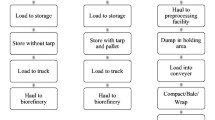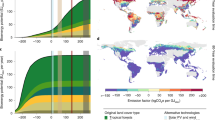Abstract
Incremental biomass losses during the harvest and storage of energy crops decrease the effective crop yield at the biorefinery gate. These losses can affect the environmental performance of biofuels from cellulosic feedstocks by indirectly increasing agricultural inputs per unit of fuel and increasing direct emissions of pollutants during biomass decomposition in storage. In this study, we expand the Greenhouse Gases, Regulated Emissions, and Energy Use in Transportation (GREETTM) model to include parameters for harvest and storage of dry bales, bale silage, and bulk silage and examine the potential impact of the biomass supply chain on energy use and air pollutants from cellulosic ethanol from corn stover, switchgrass, and miscanthus feedstocks. A review of storage methods shows substantial differences in expected losses (4.2 to 16.0 %) and variability. Model results indicate that inclusion of feedstock harvest and storage pathways increases net fossil energy consumption (0.03–0.14 MJ/MJ) and greenhouse gas emissions (2.3–10 g CO2e/MJ) from cellulosic ethanol compared to analyses that exclude feedstock losses, depending on the storage scenario selected. Greenhouse gas emissions were highest from bulk ensiled silage and bale silage pathways, driven by direct emissions of greenhouse gasses during storage and material use, respectively. Storage of dry bales indoors or under cover minimizes emissions. This report emphasizes the need to increase the detail of biofuel production models and address areas of great uncertainty in the biomass supply chain, such as biomass decomposition emissions and dry matter losses.








Similar content being viewed by others
Abbreviations
- DML:
-
Dry matter loss
- GHG:
-
Greenhouse gas
- GREET:
-
Greenhouse Gases and Regulated Emissions in Transportation
- HDPE:
-
High-density polyethylene
- LCA:
-
Life cycle analysis
- LDPE:
-
Low-density polyethylene
- LRB:
-
Large round bale
- LSB:
-
Large square bale
- PM:
-
Particulate matter
- VOC:
-
Volatile organic compounds
References
U.S. Billion-Ton Update: Biomass Supply for a Bioenergy and Bioproducts Industry (2011) Oak Ridge National Laboratory. U.S. Department of Energy, Oak Ridge
Emery IR, Mosier NS (2012) The impact of dry matter loss during herbaceous biomass storage on net greenhouse gas emissions from biofuels production. Biomass Bioenergy 39:237–246
Shinners KJ, Binversie BN, Muck RE, Weimer PJ (2007) Comparison of wet and dry corn stover harvest and storage. Biomass Bioenergy 31:211–221
Hess RJ, Kenney KL, Ovard LP, Searcy EM, Wright CT (2009) Commodity-scale production of an infrastructure-compatible bulk solid from herbaceous lignocellulosic biomass. Uniform-format bioenergy feedstock supply system design report series. Idaho National Laboratory, Idaho Falls
Sokhansanj S, Turhollow AF, Stephen J, Stumborg M, Fenton J, Mani S (2008) Analysis of five simulated straw harvest scenarios. Can Biosyst Eng 50(2):27–37
POET-DSM (2013) Biomass resources. POET-DSM. http://poetdsm.com/biomass. Accessed August 20, 2013
Tietz N (2012) Custom-baling corn stover for ethanol plants presents opportunities and challenges. Hay & Forage Grower. http://hayandforage.com/marketing/heavy-duty-biomass-harvesting. Accessed February 24, 2014
McDonald P, Henderson AR, Heron SJE (1991) The biochemistry of silage (second edition), 2nd edn. Chalcombe Publications, Marlow
Shinners KJ, Wepner AD, Muck RE, Weimer PJ (2011) Aerobic and anaerobic storage of single-pass, chopped corn stover. Bioenergy Res 4:61–75
Shinners KJ, Boettcher GC, Muck RE, Weimer PJ, Casler MD (2010) Harvest and storage of two perennial grasses as biomass feedstocks. Trans ASABE 53(2):359–370
U.S. Environmental Protection Agency: Regulation of Fuels and Fuel Additives: Changes to Renewable Fuel Standard Program; Final Rule (2010). vol 75. Federal Register, Washington
Wang M, Han J, Dunn JB, Cai H, Elgowainy A (2012) Well-to-wheels energy use and greenhouse gas emissions of ethanol from corn, sugarcane, and cellulosic biomass for US use. Environ Res Lett 7(4):045905
Jackson HA, Lessard JR (1977) Effects of moisture content on corn silage density and storage losses in a large tower silo. Can Agric Eng 19(2):57–58
Weinberg ZG, Ashbell G (1994) Changes in gas composition in corn silages in bunker silos during storage and feedout. Can Agric Eng 36(3):155–158
Henderson AR, McDonald P (1974) The effect of delayed sealing on fermentation and losses during ensilage. J Sci Food Agric 26(5):653–667
Henderson AR, McDonald P, Woolford MK (1972) Chemical changes and losses during the ensilage of wilted grass treated with formic acid. J Sci Food Agric 23(9):1079–1087
Mayne CS, Gordon FJ (1986) Effect of harvesting system on nutrient losses during silage making. 2. In-silo losses. Grass Forage Sci 41:341–351
McDonald P, Stirling AC, Henderson AR, Whittenbury R (1962) Fermentation studies on wet herbage. J Sci Food Agric 13:581–590
Richey CB, Liljedahl JB, Lechtenberg VL (1982) Corn stover harvest for energy production. Trans ASAE 25(4)
McCormick ME, Cuomo GJ, Blouin DC (1998) Annual ryegrass stored as balage, haylage, or hay for lactating dairy cows. J Prod Agric 11(3):293–300
McDonald P, Henderson AR, MacGregor AW (1968) Chemical changes and losses during the ensilage of wilted grass. J Sci Food Agric 19:125–132
McDonald P, Henderson AR, Whittenbury R (1966) The effect of temperature on ensilage. J Sci Food Agric 17:476–480
Monti A, Fazio S, Venturi G (2009) The descrepancy between plot and field yields: harvest and storage losses of switchgrass. Biomass Bioenergy 33:841–847
Kerr JAM, Brown WO (1965) A comparison of nutrient losses in baled hay made from forage—harvested, crimped or tedded swards with those in Barn Drying. J Br Grassl Soc 20:156–163
Collins A, Allinson DW (1995) Growth-rate of herbage initially dominated by Reed Canarygrass or Tall Fescue. J Prod Agric 8(2):227–232
Sanderson MA, Egg RP, Wiselogel AE (1997) Biomass losses during harvest and storage of switchgrass. Biomass Bioenergy 12(2):107–114
Cameron IH (1966) Dry matter and quality changes during and after making pasture hay. Aust J Exp Agric Anim Husb 6(23):394–401
Coble CG, Egg RP (1987) Dry matter losses during hay production and storage of sweet sorghum used for methane production. Biomass 14:209–217
Huhnke RL (1990) Round bale wheat hay storage losses. Appl Eng Agric 6(5):569–574
Khanchi A, Jones CL, Sharma B (2009) Characteristics and compositional variation in round and square sorghum bales under different storage conditions. Paper presented at the ASABE Annual International Meeting, Reno, 21-24
Verma LR, Nelson BD (1983) Changes in round bales during storage. Trans ASABE 26(2):328–332
Johnson LM, Harrison JH, Davidson D, Mahanna WC, Shinners KJ (2003) Corn silage management: effects of hybrid, maturity, innoculation, and mechanical processing on fermentation characteristics. J Dairy Sci 86:287–308
Muck RE, Holmes B (2007) Packing bunkers and piles to maximize forage preservation. In: Sixth International Dairy Housing Conference Proceeding, ASABE, Minneapolis, 16-18
Henk LL, Linden JC (1994) Silage processing of forage biomass to alcohol fuel. In: Himmel ME, Baker JO, Overend RP (eds) Enzymatic conversion of biomass for fuels production, vol 566. ACS Symposium Series, American Chemical Society, pp 391–410
Singh K, Honig H, Wermke M, Zimmer E (1996) Fermentation pattern and changes in cell wall constituents of straw-forage silages, straws and partners during storage. Anim Feed Sci Technol 61:137–153
Atchison JE, Hettenhaus JR (2004) Innovative methods for corn stover collecting, handling, storing and transporting. National Renewable Energy Laboratory, Golden
Shah A, Darr MJ, Webster K, Hoffman C (2011) Outdoor storage characteristics of single-pass large square corn stover bales in Iowa. Energies 4:1687–1695
McCormick ME, Han KJ, Moreira VR, Blouin DC, Forbes S (2011) Forage conservation efficiency and lactation response to bahiagrass conserved as barn-stored hay, outdoor-stored hay, or baleage. J Dairy Sci 94:2500–2507
Lechtenberg VL, Smith WH, Parsons SD, Petritz DC (1974) Storage and feeding of large hay packages for beef cows. J Anim Sci 39(6):1011–1015
Herrmann C, Heiermann M, Idler C (2011) Effects of ensiling, silage additives and storage period on methane formation of biogas crops. Bioresour Technol 102:5153–5161
Wyss U, Schild GJ, Honig H (1991) The influence of three different round balers on gas production and fermentation pattern of big bale silage. Paper presented at the Proceedings of a Conference on Forage Conservation towards 2000, Braunschweig
Larson JA, Mooney DF, English BC, Tyler DD (2010) Estimating the impacts of storage dry matter losses on switchgrass production. Paper presented at the Agricultural & Applied Economics Association 2010 AAEA, CAES, & WAEA Joint Annual Meeting, Denver, 25-27
Subramanyan K, Wu Y, Diwekar UM, Wang MQ (2008) New stochastic simulation capability applied to the GREET model. Int J Life Cycle Assess 13(3):278–285
Rotz CA, Muck RE (1994) Changes in forage quality during harvest and storage. Paper presented at the National Conference on Forage Quality, Evaluation, and Utilization, University of Nebraska, Lincoln, 13-15
Ebadian M, Sowlai T, Sokhansanj S, Stumborg M, Townley-Smith L (2011) A new simulation model for multi-agricultural biomass logistics system in bioenergy production. Biosyst Eng 110:280–290. doi:10.1016/j.biosystemseng.2011.08.008
Shinners KJ, Huenink BM, Muck RE, Albrecht KA (2009) Storage characteristics of large round and square alfalfa bales: low-moisture wrapped bales. Trans ASABE 52(2):401–407
Kering MK, Butler TJ, Biermacher JT, Guretzky JA (2012) Biomass yield and nutrient removal rates of perennial grasses under nitrogen fertilization. Bioenergy Res 5:61–70. doi:10.1007/s12155-011-9167-x
Hellebrand HJ (1998) Emission of nitrous oxide and other trace gases during composting of grass and green waste. J Agric Eng Res 69:365–375
De Klein C, Novoa RSA, Ogle S, Smith KA, Rochette P, Wirth TC, McConkey BG, Mosier AR, Rypdal K (2006) N2O emissions from managed soils, and CO2 emissions from lime and urea application. In: IPCC (ed) Agriculture, Forestry and Other Land Use, vol 4. 2006 IPCC Guidelines for National Greenhouse Gas Inventories. p 54
Spoelstra SF (1985) Nitrate in silage. Grass Forage Sci 40(1):1–11
Kumar A, Sokhansanj S (2007) Switchgrass (Panicum vigratum, L.) delivery to a biorefinery using integrated biomass supply analysis and logistics (IBSAL) model. Bioresour Technol 98:1033–1044
Wang Z, Dunn JB, Han J, Wang MQ (2013) Material and energy flows in the production of cellulosic feedstocks for biofuels for the GREET model. Argonne National Laboratory, Argonne
Keoleian G, Miller S, De Kleine R, Fang A, Mosley J (2011) Life cycle material data update for the GREET model. Argonne National Laboratory, Darien
Wang M, Han J, Haq Z, Tyner WE, Wu M, Elgowainy A (2011) Energy and greenhouse gas emissions effects of corn and cellulosic ethanol with technology improvements and land use changes. Biomass Bioenergy 35:1885–1896
Dunn JB, Eason J, Wang MQ (2011) Updated sugarcane and switchgrass parameters in the GREET model. Argonne National Laboratory, Argonne
Meiering AG, Courtin MG, Spoelstra SF, Pahlow G, Honig H, Subden RE, Zimmer E (1988) Fermentation kinetics and toxic gas production of silages. Trans ASAE 31(2):613–621
Wang LC, Burris RH (1960) Mass spectrometric study of nitrogenous gases produced by silage. Agric Food Chem 8(3):239–242
Montes F, Hafner S, Rotz CA Measuring emissions of volatile organic compounds from silage. In: 2009 ASABE Annual International Meeting, ASABE, Reno, 21-24
Hoglund C (1965) Some economic considerations in selecting storage systems for haylage and silage for dairy farms. Agricultural Economics Report. Michigan State University, East Lansing
Sokhansanj S, Turhollow A, Wilkerson E (2008) Development of the Integrated Biomass Supply Analysis and Logistics Model (IBSAL). Oak Ridge National Laboratory, Oak Ridge
Acknowledgments
This study was supported by the Bioenergy Technologies Office of the Energy Efficiency and Renewable Energy Office of the US Department of Energy under Contract No. DE-AC02-06CH11357. The authors thank the support and guidance of Kristen Johnson, Alicia Lindauer, and Zia Haq of the Department of Energy’s Bioenergy Technology Office. We also extend thanks to Professor Nathan Mosier of Purdue University for his contributions to the design and coordination of the study.
Authors’ Contributions
IE developed biomass storage and supply chain scenarios, including the distribution functions, and helped draft the manuscript. JD conducted the analyses and helped draft the manuscript. JH coded the GREET model revisions and helped draft the manuscript. MW provided input to the study design, review, and authorship of the manuscript.
Author information
Authors and Affiliations
Corresponding author
Rights and permissions
About this article
Cite this article
Emery, I., Dunn, J.B., Han, J. et al. Biomass Storage Options Influence Net Energy and Emissions of Cellulosic Ethanol. Bioenerg. Res. 8, 590–604 (2015). https://doi.org/10.1007/s12155-014-9539-0
Published:
Issue Date:
DOI: https://doi.org/10.1007/s12155-014-9539-0




